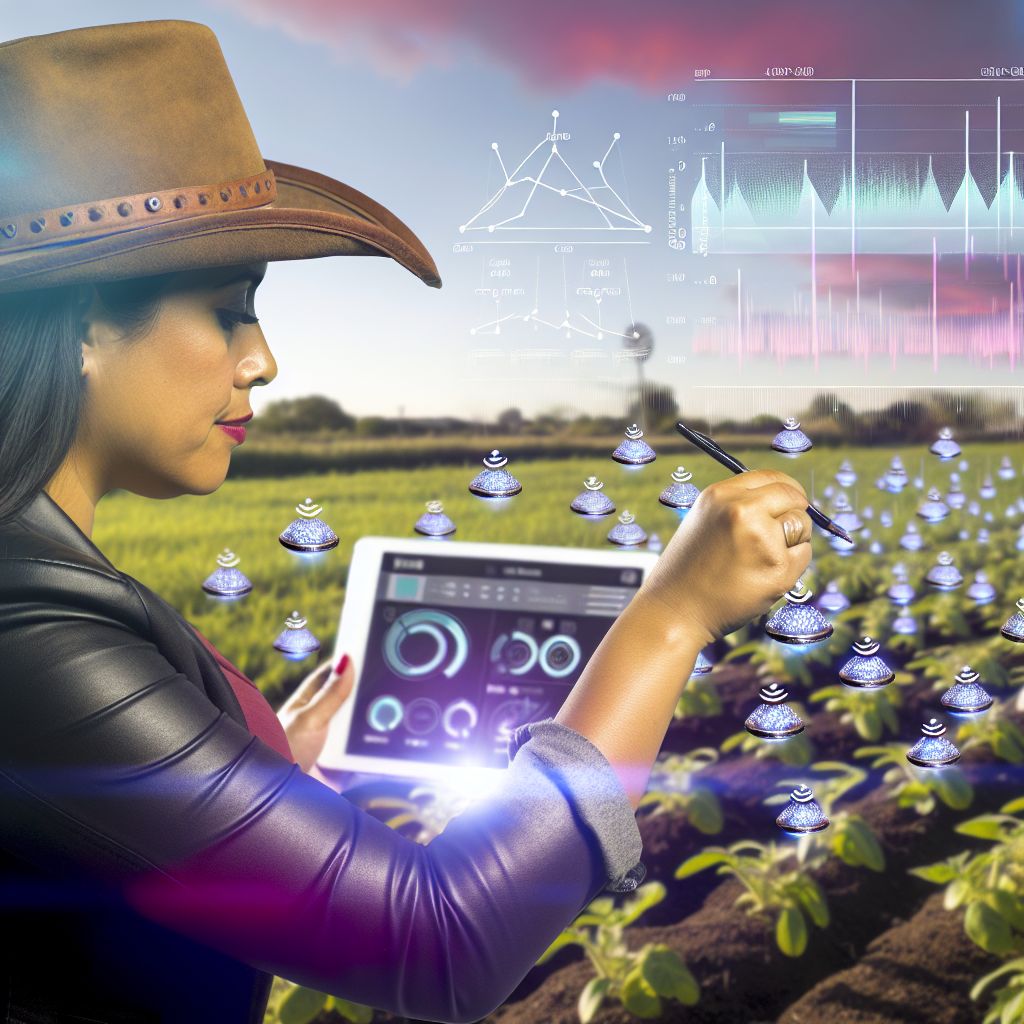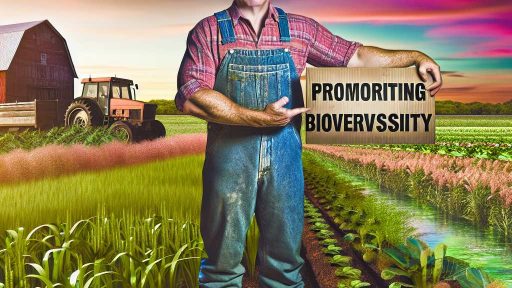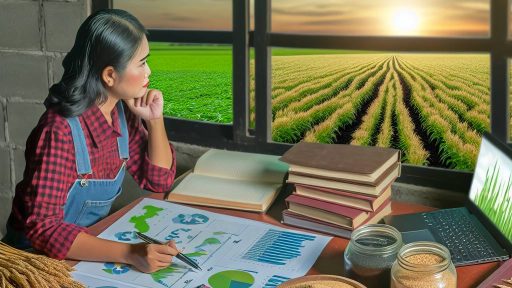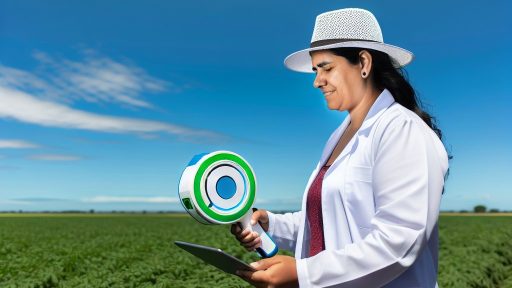Overview of IoT in Agriculture
Definition of IoT
The Internet of Things (IoT) describes a network of connected devices.
These devices communicate and share data over the internet.
They enhance automation and improve efficiency in various industries.
Significance of IoT in Agriculture
IoT plays a pivotal role in modern agriculture.
It helps farmers monitor crops in real-time.
Through sensors, they can track soil moisture and humidity.
This data aids in making informed irrigation decisions.
Benefits of Integrating IoT Devices
Integrating IoT devices offers numerous advantages.
- Increased crop yields through optimized resource use.
- Cost savings by minimizing waste and improving efficiency.
- Enhanced farm management through data analytics.
Challenges of IoT Adoption
Despite its benefits, IoT adoption faces challenges.
Connectivity issues in rural areas can hinder implementation.
Additionally, the cost of technology may be prohibitive for some farmers.
Moreover, data security remains a crucial concern.
Future Trends in IoT and Agriculture
The future of IoT in agriculture looks promising.
Innovation will continue to drive advancements in smart farming.
Emerging technologies like AI will enhance data analytics.
Transform Your Agribusiness
Unlock your farm's potential with expert advice tailored to your needs. Get actionable steps that drive real results.
Get StartedUltimately, this integration will lead to sustainable farming practices.
Benefits of Integrating IoT Devices in Farming Practices
Enhanced Efficiency and Productivity
IoT devices automate various farming tasks effectively.
This automation reduces labor costs significantly.
Farmers can operate their equipment remotely.
As a result, productivity increases across the board.
Real-time Monitoring
IoT sensors provide real-time data on crop health.
Farmers can quickly respond to issues as they arise.
This proactive approach prevents larger problems later.
Additionally, monitoring soil conditions helps optimize irrigation.
Data-Driven Decision Making
IoT devices generate valuable data for analysis.
This data helps farmers make informed decisions swiftly.
Moreover, it enables precision farming techniques.
Consequently, resources are used more efficiently.
Environmental Sustainability
Implementing IoT solutions promotes sustainable farming practices.
This integration helps reduce waste and chemical use.
Moreover, farmers can manage water resources more effectively.
Ultimately, this supports environmental conservation efforts.
Cost Savings
IoT technology significantly cuts operational costs.
Farmers spend less on water and fertilizers with smart management.
In the long run, these savings enhance profit margins.
As a bonus, the investment in IoT devices pays off quickly.
Types of IoT Devices Used in Agriculture
Sensors
Sensors play a vital role in modern agriculture.
They collect important data about soil moisture, temperature, and nutrient levels.
Farmers can use this information to make informed decisions.
Showcase Your Farming Business
Publish your professional farming services profile on our blog for a one-time fee of $200 and reach a dedicated audience of farmers and agribusiness owners.
Publish Your ProfileAdditionally, these sensors help automate irrigation systems.
This leads to water conservation and improved crop yield.
Common types of sensors include soil sensors and weather stations.
Drones
Drones have become increasingly popular in agriculture.
They provide aerial imagery that helps monitor crop health.
Farmers can identify problem areas quickly and efficiently.
This technology also assists in precise application of fertilizers and pesticides.
Moreover, drones can create detailed maps for effective planning.
Companies like AgEagle are leading the drone agricultural technology race.
Automation Tools
Automation tools streamline everyday agricultural tasks.
These tools reduce labor costs while increasing efficiency.
For instance, robotic harvesters help in the picking process.
These machines operate with minimal oversight and maximize productivity.
Also, automated tractors can perform tillage and planting activities.
Overall, automation tools revolutionize how farmers manage their fields.
Explore Further: Sustainable Farming Innovations For Higher Productivity
Challenges Faced in the Adoption of IoT Technology in Agriculture
Cost Barriers
Implementing IoT solutions often entails high initial costs.
Agricultural producers may struggle to find necessary funds.
Moreover, ongoing maintenance costs can add financial strain.
As a result, many small-scale farmers feel discouraged.
Technical Expertise Shortage
The agricultural sector faces a significant lack of technical knowledge.
Many farmers are unfamiliar with new technologies.
This knowledge gap creates obstacles to effective IoT deployment.
Training becomes essential, yet often expensive and time-consuming.
Data Management Concerns
IoT devices generate vast amounts of data.
Farmers often lack tools to analyze and utilize this data.
Thus, critical insights might be overlooked or lost.
Additionally, data security concerns can deter adoption.
Connectivity Issues
Many agricultural operations are situated in remote areas.
Poor internet connectivity limits the functionality of IoT devices.
This makes it challenging to implement consistent monitoring.
As a consequence, farmers may experience unreliable outcomes.
Regulatory Hurdles
Navigating regulations can complicate IoT adoption.
Farmers might encounter compliance challenges with data privacy laws.
Staying informed about regulatory changes adds to operational stress.
Consequently, some producers hesitate to integrate new technologies.
Explore Further: Integrating Livestock to Enhance Farm Productivity
Case Studies
Successful Implementation of IoT in Precision Agriculture
One notable case study involves GreenTech Farms.
This farm adopted IoT sensors for soil moisture monitoring.
As a result, they optimized irrigation practices significantly.
Showcase Your Farming Business
Publish your professional farming services profile on our blog for a one-time fee of $200 and reach a dedicated audience of farmers and agribusiness owners.
Publish Your ProfileThis cut water usage by 30% while improving crop yields.
Moreover, they used drone technology for crop surveillance.
This technology enabled real-time monitoring of plant health.
Irrigation Management in California
Harvest Innovations implemented smart irrigation systems.
These systems utilize weather data to schedule watering.
Consequently, the farm achieved a 25% reduction in water consumption.
Additionally, they monitored soil parameters through IoT devices.
This information guided them in making informed decisions.
Livestock Tracking in the Midwest
FarmTech Solutions specializes in livestock monitoring.
They deployed GPS collars for real-time tracking of cattle.
This reduced the time spent searching for lost animals.
Furthermore, the data collected helped optimize grazing patterns.
Thus, health issues in livestock were identified early.
Crop Monitoring in Europe
AgriSmart used IoT devices to monitor crop conditions.
The system provided alerts for diseases and pest infestations.
These alerts allowed farmers to take action swiftly.
As a result, crop losses reduced considerably.
This case underscores the value of proactive monitoring.
Implications of IoT in Agriculture
These case studies illustrate the positive impact of IoT in agriculture.
Farmers achieve significant efficiency gains through technology.
Moreover, sustainable practices become more accessible with IoT.
The integration of technology leads to a brighter agricultural future.
Uncover the Details: Financing Options To Expand And Sustain Your Farm Business

Future Trends in IoT Technology for Sustainable Agriculture
Smart Irrigation Systems
Smart irrigation systems reduce water consumption significantly.
They rely on real-time data from soil sensors.
Farmers can optimize watering schedules based on actual need.
As a result, crops thrive with minimal resource waste.
Climate Monitoring and Control
Climate monitoring systems gather data on weather patterns.
This information helps farmers make informed decisions.
Moreover, they can adjust farming practices accordingly.
Using predictive analytics enhances crop yield and quality.
Precision Agriculture
Precision agriculture utilizes drones and satellite imagery.
It allows farmers to analyze field conditions accurately.
Farmers can target specific areas needing intervention.
This method leads to better resource management and output.
Livestock Monitoring
IoT devices enhance livestock management and welfare.
Wearable technology tracks animal health and behavior.
Farmers receive alerts for any irregularities immediately.
Consequently, this leads to improved animal health and productivity.
Data-Driven Decision Making
Integration of IoT devices generates vast amounts of data.
Showcase Your Farming Business
Publish your professional farming services profile on our blog for a one-time fee of $200 and reach a dedicated audience of farmers and agribusiness owners.
Publish Your ProfileFarmers can analyze this data for actionable insights.
This process supports better risk management strategies.
Ultimately, it maximizes profitability while ensuring sustainability.
Integrating Renewable Energy Sources
Farmers increasingly adopt renewable energy solutions.
Solar panels and wind turbines complement IoT systems.
They provide sustainable energy for powering devices.
This approach reduces operational costs and carbon footprints.
Collaboration and Knowledge Sharing
IoT technology encourages collaboration among farmers.
Farmers can share data and best practices through platforms.
This fosters a community that learns and adapts together.
Additionally, research organizations provide valuable insights.
Regulatory and Security Considerations
As IoT adoption increases, so do regulatory challenges.
Farmers must ensure data privacy and security protocols.
Staying compliant will be crucial for successful integration.
Furthermore, farmers should be aware of evolving regulations.
Find Out More: Essential Insurance Policies for Modern Farmers
Impact of IoT on Crop Management and Yield Optimization
Enhancing Data Collection
IoT devices greatly enhance data collection in agriculture.
Sensors monitor soil moisture and nutrient levels in real-time.
This data allows farmers to make informed decisions quickly.
Consequently, these insights help optimize irrigation schedules.
Furthermore, pest and disease monitoring becomes more effective.
Improving Resource Management
IoT technology improves resource management on farms.
Farmers can control water usage more efficiently.
This leads to significant water savings during irrigation.
Moreover, smart irrigation systems adapt to weather changes.
Agrochemical application also becomes targeted and systematic.
Increasing Crop Monitoring and Yield
IoT devices provide real-time crop monitoring capabilities.
Farmers can use drones equipped with cameras for aerial views.
This technology captures detailed images of crop health.
With this information, they can address issues sooner.
Yield predictions also improve through accurate tracking.
Enhancing Decision-Making with Analytics
Analytics platforms leverage IoT data for strategic decision-making.
Farmers can access dashboards displaying vital information.
Such platforms enable the evaluation of historical trends effectively.
In turn, this promotes data-driven farming practices.
Eventually, it leads to improved crop yield and sustainability.
Facilitating Remote Monitoring and Control
IoT enables remote monitoring of agricultural environments.
Farmers can manage operations from their mobile devices.
This feature increases accessibility and convenience.
Additionally, it allows for quick responses to emerging issues.
Showcase Your Farming Business
Publish your professional farming services profile on our blog for a one-time fee of $200 and reach a dedicated audience of farmers and agribusiness owners.
Publish Your ProfileOverall, productivity may increase as a result.
Best Practices for Farmers Looking to Integrate IoT Solutions
Understanding IoT Integration
IoT integration involves connecting various devices to the internet.
These devices collect and share data to enhance farming efficiency.
Farmers should understand how these technologies can benefit their operations.
Assessing Current Needs
Begin by evaluating your existing farming practices.
Consider your specific needs and challenges in agricultural management.
Identifying these factors helps in selecting the right IoT solutions.
Selecting Suitable IoT Devices
Choose devices that align with your farm’s requirements.
Some common options include sensors for soil moisture and weather conditions.
Additionally, look for automated irrigation systems to optimize water usage.
Investing in Reliable Connectivity
Strong, reliable internet connectivity is crucial for IoT success.
Farmers should explore options such as satellite or cellular networks.
Ensure your connectivity is robust enough for constant data transmission.
Training and Skill Development
Invest in training programs for farm workers.
Workers need to understand how to use IoT devices effectively.
Consider partnerships with local agricultural education organizations.
Data Management and Analysis
Implement a system for analyzing the data collected from IoT devices.
Utilize software that can provide insights and recommendations.
This can help farmers make informed decisions about their crops.
Monitoring and Maintenance
Regularly monitor IoT devices to ensure they are functioning properly.
Schedule routine maintenance to avoid downtime and data loss.
Address any technical issues immediately to maintain efficiency.
Evaluating Return on Investment
Regularly assess the impact of IoT integration on your farm.
Calculate cost savings and productivity improvements from the technology.
Adjust your strategy based on performance metrics and feedback.
Additional Resources
AgTech: Ashiss Dash Of Infosys On The New Technologies That Are …




